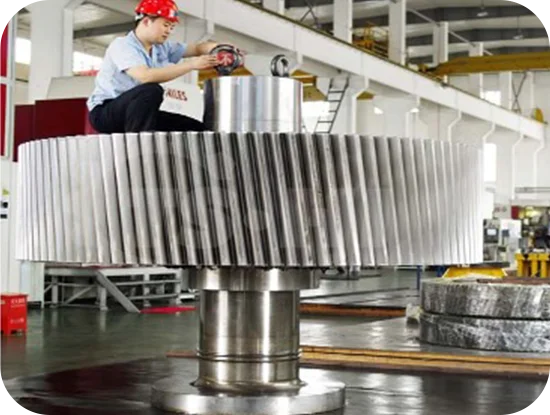Building Material Gear: The Invisible Force Behind Industrial Precision Operations

In modern industrial production, gears play an indispensable role, particularly in the building materials manufacturing industry. As the core power transmission component in building material production equipment, building material gears not only perform vital transmission functions but also directly affect the efficiency of equipment operation and the quality of products. Precision building material gears are able to operate steadily under high loads and harsh environments, ensuring the smooth operation of production lines. Therefore, understanding the application fields, manufacturing processes, and maintenance management of building material gears is crucial to improving production efficiency and extending equipment lifespan.

Precision Manufacturing Process of Building Material Gears
The manufacturing of building material gears involves several critical processes, each of which requires precise control to ensure high quality and performance. The typical manufacturing processes include forging, rough machining, heat treatment, precision machining, surface strengthening, and quality inspection.
Forging and Blank Shaping
Forging is the first step in the manufacturing process of building material gears, usually using die forging or free forging methods. During forging, the metal is plastically deformed at high temperatures, forming a more compact metal structure, which reduces defects such as porosity and cracks that may occur during casting. The forged gear blanks have better mechanical properties, especially strength and toughness, enabling them to withstand higher loads and ensure better fatigue resistance in subsequent operations.
Rough Machining and Heat Treatment Process
In the rough machining stage, the gear blanks are roughly cut to remove excess material, laying the foundation for subsequent precision machining. After rough machining, heat treatment is carried out to enhance the hardness and wear resistance of the gears. Common heat treatment processes include carburizing, quenching, and tempering. By controlling the heat treatment temperature and time, a hard carburized layer is formed on the surface of the gears, improving their wear resistance while maintaining internal toughness to avoid brittle fractures.
Precision Machining and Tooth Surface Strengthening
Precision machining is an important step in the manufacturing of building material gears, typically performed using CNC gear grinding machines. The goal of precision machining is to refine the tooth shape and pitch of the gears, ensuring smooth transmission. For high-load, high-speed building material gears, tooth surface strengthening treatments such as shot peening and nitriding are also applied. These treatments further improve the wear resistance and fatigue performance of the gears.
Precision Inspection and Quality Control
Quality control of gears is crucial, especially in the building materials industry, where gear stability directly impacts equipment performance and safety. Before shipment, building material gears undergo a series of precision inspections, including tooth profile errors, pitch errors, surface roughness, hardness testing, and non-destructive testing. Through precise inspection, it can be ensured that every gear meets the design requirements, preventing equipment failures caused by substandard machining.
Building Material Gear Lubrication and Maintenance Techniques
The operating environment for building material gears is often harsh, and lubrication and maintenance are key factors in ensuring long-term stable operation. Proper lubrication and timely maintenance not only extend the lifespan of gears but also ensure efficient equipment operation.
Lubrication Methods and Lubricant Selection
Building material gears can be lubricated using methods such as immersion lubrication, circulation lubrication, and spray lubrication. Different lubrication methods are suitable for different types of building material equipment. For example, large mixers or crushers often use circulation lubrication to ensure that the gears in the gearbox are fully lubricated, reducing friction. The selection of lubricants is also critical, and high-viscosity, anti-wear extreme pressure gear oils are commonly used. By choosing appropriate lubricants, friction and wear on the gear surface can be effectively reduced, maintaining a normal working temperature for the gears.
Routine Maintenance and Monitoring Techniques
Routine maintenance of building material gears includes regularly checking the operational status of gears, cleaning gearboxes, inspecting the quality of lubricating oil, and replacing worn components. In addition, modern industries widely use vibration monitoring, temperature monitoring, and acoustic monitoring techniques to track the operational status of gears in real-time. By analyzing data, maintenance personnel can predict potential faults and perform preventive maintenance, thereby avoiding unexpected equipment downtime or damage.
Damage and Failure Analysis
Common types of gear damage in building material gears include surface wear, pitting, tooth root cracks, and plastic deformation. Surface wear is usually caused by poor lubrication, poor gear meshing, or excessive load. Pitting is caused by the gear surface bearing high pressure over time, leading to small cracks and peeling. By deeply analyzing the causes of damage, maintenance strategies can be optimized, and corrective actions can be taken to ensure the equipment operates smoothly.
In conclusion, building material gears, as a crucial component in the building materials industry, are continuously improving through innovation and optimization, enhancing their performance and reliability. Operating under high loads and harsh conditions, building material gears play an indispensable role, ensuring the smooth and efficient operation of building material production.
https://www.tianshangear.com/Metallurgical-Building-Materials-and-Mining-Gear.html
www.tianshangear.com
Changzhou Tianshan Heavy Industry Machinery Co., Ltd.
